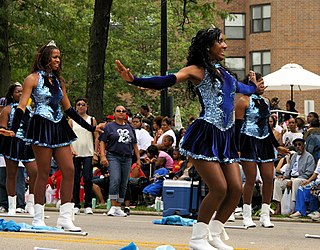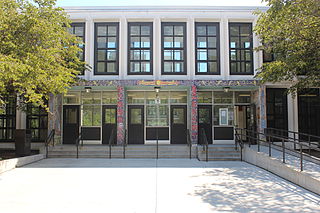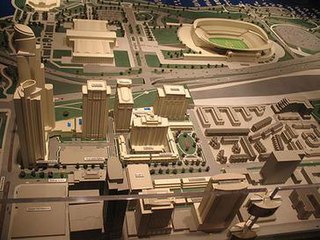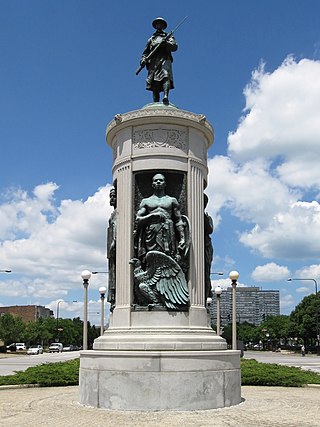Related Research Articles

Chicago is the most populous city in the U.S. state of Illinois and in the Midwestern United States. With a population of 2,746,388, as of the 2020 census, it is the third-most populous city in the United States after New York City and Los Angeles. As the seat of Cook County, the second-most populous county in the U.S., Chicago is the center of the Chicago metropolitan area, often colloquially called "Chicagoland" and home to 9.6 million residents.

Hull House was a settlement house in Chicago, Illinois, that was co-founded in 1889 by Jane Addams and Ellen Gates Starr. Located on the Near West Side of Chicago, Hull House, named after the original house's first owner Charles Jerald Hull, opened to serve recently arrived European immigrants. By 1911, Hull House had expanded to 13 buildings. In 1912, the Hull House complex was completed with the addition of a summer camp, the Bowen Country Club. With its innovative social, educational, and artistic programs, Hull House became the standard bearer for the movement; by 1920, it grew to approximately 500 settlement houses nationally.

Hyde Park is a neighborhood on the South Side of Chicago, Illinois, located on and near the shore of Lake Michigan 7 miles (11 km) south of the Loop. It is one of the city's 77 community areas.

Washington Park is a community area on the South Side of Chicago which includes the 372 acre (1.5 km2) park of the same name, stretching east-west from Cottage Grove Avenue to the Dan Ryan Expressway, and north-south from 51st Street to 63rd. It is home to the DuSable Museum of African American History. The park was the proposed site of the Olympic Stadium and the Olympic Aquatics Center in Chicago's bid to host the 2016 Summer Olympics.

Austin is one of 77 community areas in Chicago. Located on the city's West Side, it is the third-largest community area by population and the second-largest geographically. Austin's eastern boundary is the Belt Railway located just east of Cicero Avenue. Its northernmost border is the Milwaukee District / West Line. Its southernmost border is at Roosevelt Road from the Belt Railway west to Austin Boulevard. The northernmost portion, north of North Avenue, extends west to Harlem Avenue, abutting Elmwood Park. In addition to Elmwood Park, Austin also borders the suburbs of Cicero and Oak Park.

Kenwood, one of Chicago's 77 community areas, is on the shore of Lake Michigan on the South Side of the city. Its boundaries are 43rd Street, 51st Street, Cottage Grove Avenue, and the lake. Kenwood was originally part of Hyde Park Township, which was annexed to the city of Chicago in 1889. Kenwood was once one of Chicago's most affluent neighborhoods, and it still has some of the largest single-family homes in the city. It contains two Chicago Landmark districts, Kenwood and North Kenwood. A large part of the southern half of the community area is in the Hyde Park-Kenwood Historic District. In recent years, Kenwood has received national attention as the home of former U.S. President Barack Obama.

The Hyde Park Art Center (HPAC) is a visual arts organization and the oldest alternative exhibition space in the city of Chicago. Since 2006, HPAC has been located just north of Hyde Park Boulevard, at 5020 S.Cornell Avenue, in the Kenwood neighborhood of Chicago, Illinois.

Kenwood Academy is a comprehensive public four-year high school, with a middle school magnet program for gifted students, located in the Hyde Park–Kenwood neighborhood on the south side of Chicago, Illinois, United States. Operated by the Chicago Public Schools (CPS) district, Kenwood opened in temporary quarters in 1966 and in its permanent building in 1969. Kenwood limits acceptance of high school students to those living in Hyde Park: from Lake Michigan to Cottage Grove Avenue east to west, and 47th to the Midway Plaisance north to south. Kenwood was recognized as a "School of Distinction" for its academic achievement and a Model School by the International Center for Leadership in Education in 2004.

Paul Cornell was an American lawyer and Chicago real estate speculator who founded the Hyde Park Township that included most of what are now known as the south and far southeast sides of Chicago in Cook County, Illinois, United States. He turned the south side Lake Michigan lakefront area, especially the Hyde Park community area and neighboring Kenwood and Woodlawn neighborhoods, into a resort community that had its heyday from the 1850s through the early 20th century. He was also an urban planner who paved the way for and preserved many of the parks that are now in the Chicago Park District. Additionally, he was a successful entrepreneur with interests in manufacturing, cemeteries, and hotels.

Washington Park is a 372-acre (1.5 km2) park between Cottage Grove Avenue and Martin Luther King Drive, located at 5531 S. Martin Luther King Dr. in the Washington Park community area on the South Side of Chicago. It was named for President George Washington in 1880. Washington Park is the largest of four Chicago Park District parks named after persons surnamed Washington. Located in the park is the DuSable Museum of African American History. This park was the proposed site of the Olympic Stadium and the Olympic swimming venue for Chicago's bid to host the 2016 Summer Olympics. Washington Park was added to the National Register of Historic Places on August 20, 2004.

Washington Square, also known as Washington Square Park, is a park in Chicago, Illinois. A registered historic landmark that is better known by its nickname Bughouse Square, it was the most celebrated open air free-speech center in the country as well as a popular Chicago tourist attraction. It is located across Walton Street from Newberry Library at 901 N. Clark Street in the Near North Side community area of Chicago, Illinois, United States. It is Chicago's oldest existing small park. It is one of four Chicago Park District parks named after persons surnamed Washington. It was added to the National Register of Historic Places on May 20, 1991.

Central Station is a residential development project in the South Loop section of Chicago, Illinois. Originally planned as a 69 acres (28 ha) development, it was later expanded to 72 acres (29 ha), and is now 80 acres (32 ha). Being planned by the city government, it encompasses the former rail yards and air space rights east of Michigan Avenue between Roosevelt Road and 18th Street.
The Chicago Imagists are a group of representational artists associated with the School of the Art Institute of Chicago who exhibited at the Hyde Park Art Center in the late 1960s.

Hyde Park Township is a former civil township in Cook County, Illinois, United States that existed as a separate municipality from 1861 until 1889 when it was annexed into the city of Chicago. Its borders are Pershing Road on the north, State Street on the west, Lake Michigan and the Indiana state line on the east, and 138th Street and the Calumet River on the south. This region comprised much of what is now known as the South Side of Chicago.

The South Side is one of the three major sections of the city of Chicago, Illinois, United States. Geographically, it is the largest of the three sections of the city, with the other two being the North and West Sides. It radiates and lies south of the city's downtown area, the Chicago Loop.

Indian Village is the small southeast corner of Kenwood, a community area on the South Side of Chicago, Illinois, United States. It is bounded by Lake Shore Drive to the east, Burnham Park to the north, 51st Street to the south, Harold Washington Park to the southeast, and the Illinois Central Railroad tracks used by the South Shore and Metra Electric Lines to the west. Many of the buildings in the neighborhood are named after American Indian tribes including the National Register of Historic Places (NRHP)-designated Narragansett; the Powhatan Apartments, a Chicago Landmark; the Chippewa; and the Algonquin Apartment buildings.
Visual arts of Chicago refers to paintings, prints, illustrations, textile art, sculpture, ceramics and other visual artworks produced in Chicago or by people with a connection to Chicago. Since World War II, Chicago visual art has had a strong individualistic streak, little influenced by outside fashions. "One of the unique characteristics of Chicago," said Pennsylvania Academy of Fine Arts curator Bob Cozzolino, "is there's always been a very pronounced effort to not be derivative, to not follow the status quo." The Chicago art world has been described as having "a stubborn sense ... of tolerant pluralism." However, Chicago's art scene is "critically neglected." Critic Andrew Patner has said, "Chicago's commitment to figurative painting, dating back to the post-War period, has often put it at odds with New York critics and dealers." It is argued that Chicago art is rarely found in Chicago museums; some of the most remarkable Chicago artworks are found in other cities.

Richard Wetzel is an American artist. He is best known for his oil paintings but also has exhibited collages and sculpture. In 1969 and 1970, Wetzel exhibited with the Chicago Imagists, a grouping of Chicago artists who were ascendant in the late 1960s and early 1970s.

Don Baum was an American curator, artist and educator, most known as a key impresario and promoter of the Chicago Imagists, a group of artists that had an enduring impact on American art in the later twentieth century. Described by the Museum of Contemporary Art, Chicago (MCA) as "an indispensable curator of the Chicago school," Baum was known for lively and irreverent exhibitions that offered fresh perspectives combining elements of Surrealism and Pop and that broke down barriers between schooled and untrained, or so-called outsider artists. From 1956 to 1972, Baum was exhibitions director at Chicago's Hyde Park Art Center. It was there, in the 1960s, that he became involved with a group of young artists he exhibited as "Hairy Who" that later expanded to become the Chicago Imagists. That group included Ed Paschke, Jim Nutt, Roger Brown, Gladys Nilsson, and Karl Wirsum. Baum mounted two major shows at the MCA that featured the emerging artists in their first museum exhibitions: "Don Baum Sez: 'Chicago Needs Famous Artists'" (1969) and "Made in Chicago" (1973), which shaped a vision of Chicago's art world as a place of meticulous craftsmanship and vernacular inspiration.
References
- ↑ "Museum Facts". The Museum of Science and Industry. Archived from the original on 15 August 2012. Retrieved 3 August 2012.
- ↑ "Hyde Park Art Center". Hyde Park Art Center. Retrieved 3 August 2012.
- ↑ Reich, Howard (March 21, 2004). "Herbie's blues". Chicago Tribune. Retrieved 2 August 2012.
- ↑ "Joe and Rika Mansueto Library, University of Chicago, Chicago, IL, (building)". Celsus: A Library Architecture Resource. Retrieved 2 August 2012.
- ↑ "Chicago Cultural Plan 2012 Draft" (PDF). City of Chicago and Department of Cultural Affairs and Special Events. Archived from the original on 13 August 2012. Retrieved 3 August 2012.
- ↑ "Paul Cornell - Founder of Hyde Park". Hyde Park Historical Society. Archived from the original on 4 February 2012. Retrieved 2 August 2012.
- ↑ Ann Durkin Keating (2004). James R. Grossman; Ann Durkin Keating; Janice L. Reiff (eds.). The Encyclopedia of Chicago. University Of Chicago Press. ISBN 0226310159.
- ↑ "Hyde Park Community Collection 1874-1988". Chicago Public Library Special Collections and Preservation Division. Retrieved 3 August 2012.
- ↑ James R. Grossman; Ann Durkin Keating; Janice L. Reiff, eds. (2004). The Encyclopedia of Chicago. University Of Chicago Press. ISBN 0226310159.
- ↑ "World Columbian Exposition (1893)". Chicago Tribune. Retrieved 3 August 2012.
- ↑ James R. Grossman; Ann Durkin Keating; Janice L. Reiff, eds. (2004). The Encyclopedia of Chicago. University Of Chicago Press. ISBN 0226310159.
- ↑ "Parks". The University of Chicago Civic Knowledge Project. Retrieved 3 August 2012.
- ↑ James R. Grossman; Ann Durkin Keating; Janice L. Reiff, eds. (2004). The Encyclopedia of Chicago. University Of Chicago Press. ISBN 0226310159.
- ↑ "Museum of Science and Industry Museum History". Museum of Science and Industry. Archived from the original on 8 August 2012. Retrieved 3 August 2012.
- ↑ "Museum of Science and Industry Museum Facts". Museum of Science and Industry. Archived from the original on 15 August 2012. Retrieved 3 August 2012.
- ↑ Teachout, Terry (December 22, 2006). "In America, All the Land's a Stage". The Wall Street Journal.
- ↑ "History of the University". The University of Chicago. Archived from the original on 16 April 2010. Retrieved 5 August 2012.
- ↑ "University of Chicago Enrollment by Academic Unit, by Academic Status, Census Spring 2012" (PDF). The University of Chicago Registrar. Archived from the original (PDF) on 14 July 2012. Retrieved 3 August 2012.
- ↑ "University of Chicago Facts and Figures". The University of Chicago Admissions Office. Archived from the original on 22 July 2012. Retrieved 3 August 2012.
- ↑ "Joe "King" Oliver". PBS: Jazz, A Film By Ken Burns. Retrieved 6 August 2012.
- ↑ "King Oliver's Creole Jazz Band". The Red Hot Jazz Archive. Archived from the original on 15 July 2019. Retrieved 6 August 2012.
- ↑ "Key to Map of Chicago South Side Jazz c.1915-c.1930". Chicago Jazz Archive, The University of Chicago Library. Retrieved 3 August 2012.
- ↑ Dold, R. Bruce (October 12, 1989). "Roads Less Traveled". Chicago Tribune. Retrieved 6 August 2012.
- ↑ "Best of Chicago 2011: Arts & Culture". Chicago Magazine. August 2011.
- ↑ Reich, Howard (July 16, 2012). "Miguel Zenon to headline Hyde Park Jazz Festival". Chicago Tribune.
- ↑ "UCP History". The University of Chicago Presents. Retrieved 3 August 2012.
- ↑ "Theater and Performance Studies". The University of Chicago. Retrieved 3 August 2012.
- ↑ "The School, Profile". Hyde Park School of Dance. Retrieved 3 August 2012.
- ↑ "Feast: Radical Hospitality in Contemporary Art". Smart Museum of Art. Retrieved 3 August 2012.
- ↑ Artner, Alan G. (October 4, 1987). "Imagist Revival". Chicago Tribune. Retrieved 6 August 2012.
- ↑ "Don Baum: In Memoriam". Museum of Contemporary Art Chicago. Archived from the original on 23 October 2013. Retrieved 6 August 2012.
- ↑ "Review: Seymour Rosofsky/Elmhurst Art Museum". New City Art. May 30, 2011. Retrieved 6 August 2012.
- ↑ Loerzel, Robert (January 27, 2011). "Assorted Nutts". Chicago Reader. Retrieved 6 August 2012.
- ↑ James R. Grossman; Ann Durkin Keating; Janice L. Reiff, eds. (2004). The Encyclopedia of Chicago. University Of Chicago Press. ISBN 0226310159.
- ↑ "Dawoud Bey". The Renaissance Society. Archived from the original on 7 August 2012. Retrieved 3 August 2012.
- ↑ "History". 57th Street Art Fair. Archived from the original on 4 June 2012. Retrieved 3 August 2012.
- ↑ "About the Prairie Style". Frank Lloyd Wright Preservation Trust. Archived from the original on 23 August 2012. Retrieved 3 August 2012.
- ↑ "Wright House Goes On Trust's Roster". Chicago Tribune. October 22, 1996.
- ↑ "Howard Van Doren Shaw in Hyde Park". Hyde Park-Kenwood Community Conference. Archived from the original on 16 April 2007. Retrieved 7 August 2012.
- ↑ "Joe and Rika Mansueto Library - Winner". AIA Chicago. Archived from the original on 16 June 2012. Retrieved 3 August 2012.
- ↑ "University of Chicago wins CAF Patron of the Year Award for Mansueto Library". The University of Chicago Library News. Retrieved 3 August 2012.
- ↑ "SCUP Excellence in Landscape Architecture - General Design, Honor Award". Society for College and University Planning. Archived from the original on 23 October 2013. Retrieved 3 August 2012.
- ↑ Kamin, Blair (March 8, 2011). "Right out of 'Star Wars,' a new way to light a path at U. of C.; 40-foot-tall light masts inspired by Olmsted's vision for the Midway". Chicago Tribune.
- ↑ "Logan Center: The Design". The University of Chicago, UChicago Arts. Archived from the original on 26 July 2012. Retrieved 3 August 2012.
- ↑ Kamin, Blair (March 25, 2012). "U. of C.'s big muse on campus; expectations rise along with Logan Center for the Arts, designed by architects Williams and Tsien". Chicago Tribune.
- ↑ "About the Reva and David Logan Center for the Arts". The University of Chicago, UChicago Arts. Archived from the original on 16 July 2012. Retrieved 3 August 2012.
- ↑ "Arts and Literature". The University of Chicago Civic Knowledge Project. Retrieved 3 August 2012.
- ↑ "Arts and Literature". The University of Chicago Civic Knowledge Project. Retrieved 3 August 2012.
- ↑ "Arts and Literature". The University of Chicago Civic Knowledge Project. Retrieved 3 August 2012.
- ↑ "Hyde Park Booksellers Association". Powell's Bookstores Chicago. Archived from the original on 15 April 2012. Retrieved 3 August 2012.
- ↑ Turner Trice, Dawn (January 30, 2012). "Little Black Pearl art center is a jewel for North Kenwood neighborhood". Chicago Tribune.
- ↑ Schier, Anna (Jul 20, 2010). "Gallery Spotlight: Little Black Pearl". Chicago Art Magazine.
- ↑ "Occupants, Projects & Sponsorships". Experimental Station. Archived from the original on 27 June 2012. Retrieved 3 August 2012.
- ↑ Green, Yolanda (January 4, 2011). "Theaster Gates: The Dorchester Project". Chicago Art Magazine.
- ↑ Cromidas, Rachel (April 7, 2011). "In Grand Crossing, a House Becomes a Home for Art". The New York Times.
- ↑ O'Connor, Maura R. (July 2, 2012). "The Right to Experience Art". The Atlantic.
- ↑ Coward, Kyle (June 24, 2011). "After 'Art Here Art Now'". Red Eye Chicago. Archived from the original on January 4, 2013.